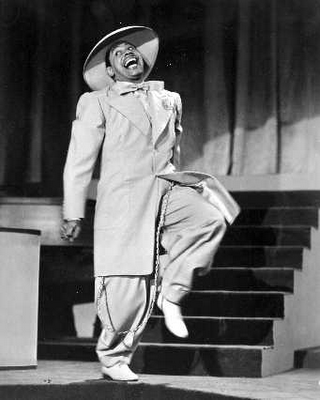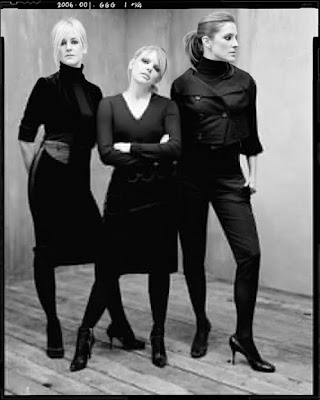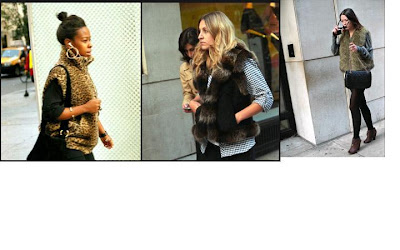ZOOT SUIT
Zoot Suit, now mostly forgotten, has had an enormous political role in the racially tense world of the 1940s in the U.S. As mentioned in the History Workshop Journal, "the zoot-suit is more than an exaggerated costume, more than a sartorial statement, it is the bearer of a complex and contradictory history… It was, in the most direct and obvious ways, an emblem of ethnicity and a way of negotiating an identity.”
Zoot Suit, now mostly forgotten, has had an enormous political role in the racially tense world of the 1940s in the U.S. As mentioned in the History Workshop Journal, "the zoot-suit is more than an exaggerated costume, more than a sartorial statement, it is the bearer of a complex and contradictory history… It was, in the most direct and obvious ways, an emblem of ethnicity and a way of negotiating an identity.”

The zoot suit was also associated with the unfortunate 1942 riots in Los Angeles, the subject of a 1981 PBS movie named Zoot Suit Riots, written, produced and directed by Joseph Tovares. Here are excerpts from PBS:
“ In August 1942 the murder of a young Mexican-American man ignited a firestorm in the City of the Angels. In no time at all, ethnic and racial tensions that had been building up over the years boiled over. Police fanned out across the city in a dragnet that netted 600 Mexican Americans. Among those accused of murder was a young "zoot-suiter" named Hank Leyvas -- the poster boy for an entire generation of rebellious Mexican kids who refused to play by the old rules. As he and sixteen other boys headed to trial, the mood of the city turned violent. The deck was stacked against the defendants, and a verdict of guilty would spark a series of brutal riots. The convictions were ultimately overturned, but the city and its inhabitants would be forever changed."
"Zoot Suit" Look, Dior Homme, Fall 2008
Emanuel Ungaro, Zoot suit, U.S, Fall/Winter Collection 2008 (below)
TEDDY BOY - NEO EDWARDIANS
A photograph by Jimmy Forsyth: Scotswood Teddy Boys, date unknown (below).
Wearing the favored Edwardian style of dress, two ' Teddy Boys' pose for a photographer on a street in Manchester, UK, in 1955.
"Teddy Boy" Look; Commes des Garcon, Winter 2009 (below).
BEATNIK
Late San Francisco Chronicle columnist Herb Caen coined the word "beatnik'' on April 2, 1958, six months after the Soviets launched the Sputnik satellite into space. "Look magazine, preparing a picture spread on S.F.'s beat generation (oh, no, not AGAIN!),'' read an item in Caen's April 2 column, "hosted a party in a No. Beach house for 50 beatniks, and by the time word got around the sour grapevine, over 250 bearded cats and kits were on hand, slopping up Mike Cowles' free booze. They're only beat, y'know, when it comes to work.'' (Source sfgate.com)
Encyclopedia Britannica describes beatnik as “American social and literary movement originating in the 1950s and centered in the bohemian artist communities of San Francisco’s North Beach, Los Angeles’ Venice West, and New York City’s Greenwich Village. Its adherents, self-styled as “beat” (originally meaning “weary,” but later also connoting a musical sense, a “beatific” spirituality, and other meanings) and derisively called “beatniks,” expressed their alienation from conventional, or “square,” society by adopting an almost uniform style of seedy dress, manners, and “hip” vocabulary borrowed from jazz musicians.”
Below is a beatnik Audrey Hepburn, in "Funny Face” 1957
In more current times, the Dixie Chicks are the highest selling female group in any genre. They hold the distinction of being the only country group in history and the only female group of any genre to earn back-to-back Diamond Awards signifying 10 million in record sales (source dixiechicks.com). Below is a photo of them in beatnik style.
The late Yves Saint Laurent was said to have been a hugely influencial designer on Beatnik fashion with introduction of sleek menswear looks to women’s fashion. Also from the 60s came Beatnik chic - a black leather jacket and knit turtleneck with high boots - and sleek pantsuits that underlined his statement on equality of the sexes. He showed that women could wear "men's clothes," which when tailored to the female form became an emblem of elegant femininity. This style (along with the bob reminiscent of mod) was in display at the designers fall/winter 2008 catwalk show in Paris on February 28, 2008.
The “Mod” (for modern) look of the 1960’s was characterized by innovative, creative, bold and brash outfits and the use of the scooters. Mini dress was also made popular in this era by Mary Quant.
Quadrophenia, the Who’s tribute to Jimmy the Mod is a flamboyant mix of scooters, pills and sea side battles with rockers. The plot for this 1979 film is as follows (source IMDB): "London, 1965: Like many other youths, Jimmy hates the philistine life, especially his parents and his job in a company's mailing division. Only when he's together with his friends, a 'Mod' clique, cruises London on his motor-scooter and hears music such as that of 'The Who' and 'The High Numbers', he feels free and accepted. However, it's a flight into an illusionary world.”
Below are some images from the mod era (source Rose Hill):

Designers such as Mary Quant was prominent during this time as was the model Twiggy.
Below, Mary Quant having her hair done by stylist Vidal Sassoon, who originated her hairdo, known as the bob, a short, angular hairstyle cut on a horizontal plane.
Twiggy, the first super-skinny supermodel with her bob is shown below.
Below are celebrities wearing the sixties mod fashion from designers Balenciaga, Chloé, Corey Linn Calter, and Alice + Olivia.
Hippies on Mount Tamalpais: Gathering" on Mount Tamalpais , 1969.
Donna Karen Spring 2009 (below)
Rebecca Taylor Spring 2009 (below)
The disco look was made fashionable by the 1977 movie Saturday Night Fever. John Travolta's blow-dried hair, tight, shiny polyester duds, platform shoes and the white suit created the disco trend in fashion.
"Donatella Versace works the 80's revival going on in fashion right now by bringing sexy back old school brother Gianni style. No one could do sexy like Gianni Versace, but his sister comes close. Mini dresses detailed with corset lacing. Tight fitting jersey tops, with postage size miniskirts, some with a peek-a-boo of plastic on top. (Start searching the vintage stores now for those old Versace Medusa prints). Its all new and fresh. Updated for the new millennium. "
Similarly, for Spring, "...Decarnin brought out another whammy of a no-brainer blockbuster for Balmain: disco cavewoman goes to the front " (Sarah Mower).
PUNK
From Encyclopedia Brittanica: "Punk (rock) is an aggressive form of rock music that coalesced into an international (though predominantly Anglo-American) movement in 1975–80. Often politicized and full of vital energy beneath a sarcastic, hostile facade, punk spread as an ideology and an aesthetic approach, becoming an archetype of teen rebellion and alienation. After the pastoral concerns of the hippies, punk was a celebration of urbanism, a reclaiming of the inner city. The term spread to Britain, where the Sex Pistols were packaged by Malcolm McLaren to promote his London store, Sex, which sold fetishistic clothing daubed with slogans from the 1960s radical politics... Announced by their manifesto, the single “Anarchy in the U.K.,” the Sex Pistols established punk as a national style that combined confrontational fashions with sped-up hard rock and allusive, socially aware lyrics that addressed the reduced expectations of 1970s teens. "
The Ramones (below)
Sex Pistols

Among the fashion designers, In 1970, Vivienne Westwood shook up British fashion indelibly. She and then-partner Malcolm McLaren of the Sex Pistols opened a store on Kings Road, called Let it Rock, which functioned as an outlet for the two to showcase their respective interests (source New York Magazine).
HIP HOP
According to Encyclopedia Brittanica, although widely considered a synonym for rap music, the term hip-hop refers to a complex culture comprising four elements: deejaying, or “turntabling”; rapping, also known as “MCing” or “rhyming”; graffiti painting, also known as “graf” or “writing”; and “B-boying,” which encompasses hip-hop dance, style, and attitude, along with the sort of virile body language that philosopher Cornel West described as “postural semantics.” Hip-hop originated in the predominantly African American, economically depressed South Bronx section of New York City in the late 1970s.
Upon inception, the hip hop scene spurned a unique street style of jumpsuits, sneakers, casual separates, and elaborate jewelry.
Below is a collection of hip hop album covers.
Formed in the Bronx, New York City, in 1976, Grandmaster Flash and the Furious Five were one of the first multimember rapping crews.
According to a February 2002 article in the New York Times , in the two years since Sean Combs started his clothing label Sean John, for which he directs design, the company has easily lapped its competitors in the urban fashion market, gaining on well-established labels like Fubu, Phat Farm and Ecko, whose customers are primarily young men who favor the loose, hip-hop inspired clothing that has become both an urban and suburban uniform. “He has been Sean Combs and Puff Daddy and now styles himself P. Diddy. He has been a rap mogul, a multiplatinum-selling recording artist and producer, a celebrity consort and also a criminal defendant. Now, as Fashion Week begins, Sean John Combs, 32, originally of Yonkers, is the biggest comer on Seventh Avenue. Sean John is sold in 1,200 stores across the country, with retail revenue of over $200 million last year, according to the privately held company.”
NEW STREET TRENDS
SLEEVELESS TOPPER
One of the current street trends seems to be the sleeveless topper according to Bill Cunnigham of The New York Times. Women who are not ready yet for their winter coat are wearing them, to keep warm in cool mornings, and not too hot at lunch time. According to Cunningham, it represents the transitional spirit of New York and the change in the season.
Below are some photos from the streets of New York:
The sleeveless fur has been incorporated into Fall/Winter 2009 collections of Jean-PaulGaultier, Marni, Louis Vuitton, and Etro (below).
In a September 2009 New York Times article, Suzy Menkes states that the Topshop Unique fashion show proved why the British fast-fashion chain, which has now set out to conquer the United States, is at the beating heart of London style. According to Menkes, “the collection picked up on all the current street style, focusing on down-and-dirty denim, worn as brief shorts over stretch biker mini-leggings, bra tops or coats teamed with graffiti-patterned pants. The models, with their bubble gum pink lips and tumbled, messy hair, had the sexual charge and fashion energy that has characterized the city since the days of “Swinging London” in the 1960s.”
Below are pictures from the Spring RTW 2010 show.

Below are pictures from the Spring RTW 2010 show.














































